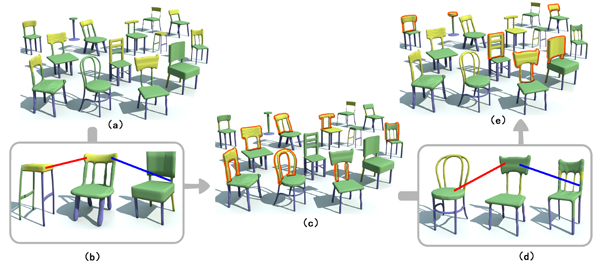Active Co-Analysis of a Set of ShapesACM Transactions on Graphics(Proceedings of SIGGRAPH Asia 2012) |
||
|
Yunhai Wang1
Shmulik Asafi2
Oliver van Kaick3
Hao Zhang3
Daniel Cohen-Or2
Baoquan Chen1 |
||
|
Figure 1: Overview of our active co-analysis: (a) We start with an initial co-segmentation of the set obtained in an unsupervised manner. (b) Pairs of super-faces that require a constraint are suggested by the system, and the user interactively adds the necessary constraints. In this example, the user adds a cannot-link constraint (in red) and a must-link constraint (in blue) between super-faces. (c) The constraints are propagated to the set and the co-segmentation is refined. The process from (b) to (c) is repeated until the desired result is obtained. |
||
AbstractUnsupervised co-analysis of a set of shapes is a difficult problem since the geometry of the shapes alone cannot always fully describe the semantics of parts. In this paper, we consider the use of a semi-supervised learning method where the user actively assists in the co-analysis by iteratively providing input that progressively constrains the system. We introduce a novel constrained clustering method based on a spring system which embeds elements to better respect their inter-distances in feature space together with the user given set of constraints. We also present an active learning method that suggests to the user where his input is likely to be the most effective in refining the results. We show that each single pair of constraints affects many relations across the set. Thus, the method requires only a sparse set of constraints to quickly converge toward a consistent error-free semantic labeling of the set. |
||
Video |
||
Paper and Supplemental material |
||
Results |
||
|
|
||
|
Figure 2: Two iterations in the active co-analysis of a set, starting from the unsupervised result in (a). Notice how the constraints added by the user in (b) and (d) have a significant effect and refine the segmentation for several shapes (refined segments are marked in red). |
||
|
|
||
|
Figure 3: Large tele-alien set: 200 shapes. (left) The initial co-segmentation result; (right) The co-segmenation result after the user specifes 108 constraints. |
||
|
||
|
Figure 4: Large vase set: 300 shapes. (left) The initial co-segmentation result; (right) The co-segmenation result after the user specifes 44 constraints. |
||
DataTo evaluate our active co-analysis, we developed a 3D shape co-segmenation dataset. You can download all the sets of shapes we used from there. | ||
AcknowledgementsThe authors would like to thank all the reviewers for their valuable comments. This work is supported in part by grants from NSFC (61202222, 61232011, 61025012), Guangdong Science and Technology Program (2011B050200007), National 863 Program (2011AA010503), Shenzhen Science and Innovation Program (CXB201104220029A, JC201005270329A), NSERC (611370) and the Israel Science Foundation. |
||
|
|
||



